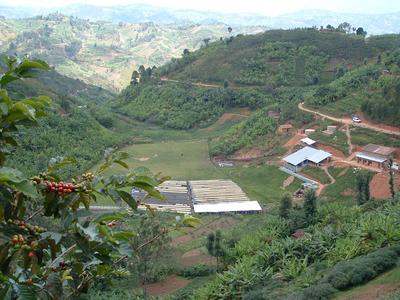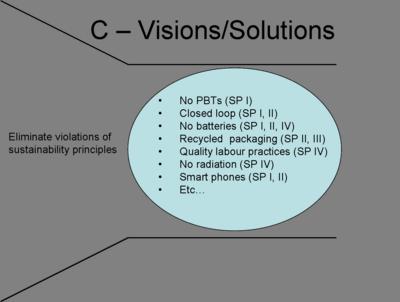Our group went with a cell phone company, and pretended we were a group of consultants presenting the results to our newly hired consultants in training. Another group went with a fictional local restaurant, one did a funeral business / mortuary, another did Absolute vodka, and my personal favorite was the one group that chose a real-life topic, which was Pierre’s (a great guy in our program from
All of the presentations followed pretty much the same format, in that they started with a quick overview of “A” – that is defining (1) the system (that particular organization within society within the biosphere) and how that system is akin to the funnel metaphor; (2) success in terms of sustainability (not violating the 4 sustainability principles); and (3) some strategic guidelines (in particular the concept of backcasting, which is what the group would be doing in steps “B” and “C”).
Then they described how “B” went – and there were a lot of assumptions and generalizations, because the point wasn’t really to get a full handle on the topic, but to learn the process. Also, when you do it for real, you let the group of experts do all the talking, so you don’t really need to know specifics of the operation. So all of the “B” sections had a bunch of examples as to how the present operations violated the 4 principles. So the Vodka group, for example talked about CO2 (from energy in buildings and distilling processes, transporting the product, etc) (violating Sustainability Principle I) and about the farm land used for the grains (SP III) and the pesticides and fertilizers used in the farming (SP II) as well as problems with alcoholism (SP IV) and drunk driving (SP IV). Our group’s slide for B looked like this:
Then on to “C” where the hypothetical groups started brainstorming about solutions and an ideal vision of the future, without regard for what might not actually seem possible or feasible today (due to limitations in cost or technology, etc). So the coffee plantation group talked about a chemical-free farm, and a bean-cleaning operation that used recycled water and renewable energy, and a living wage for workers ($1 per day vs. the $0.60 they currently get, which is already higher than the $0.40 average for the area). Some of the examples for our cell phone company were:
Then we got to “D” where you start prioritizing immediate actions the company can take (keeping in mind that those actions need to be in the right direction towards “C”, they are flexible enough to adapt to unforeseeable changes on the way to “C” and they provide a good ROI so the company does well and has extra $ to reinvest in more challenging sustainability options down the road). The funeral group talked about biodegradable caskets, vertical burying, alternative embalming techniques… (this presentation brought up a lot of interesting talk about cultural considerations and the importance of traditions, and how they can change – our current land-use intensive burial practices haven’t really been around all that long). Here's our D slide:
And that was that – good practice to go through the steps again, and play around with different examples and very interesting to see how it works with any organization and application, even weird ones like funeral operations.





No comments:
Post a Comment